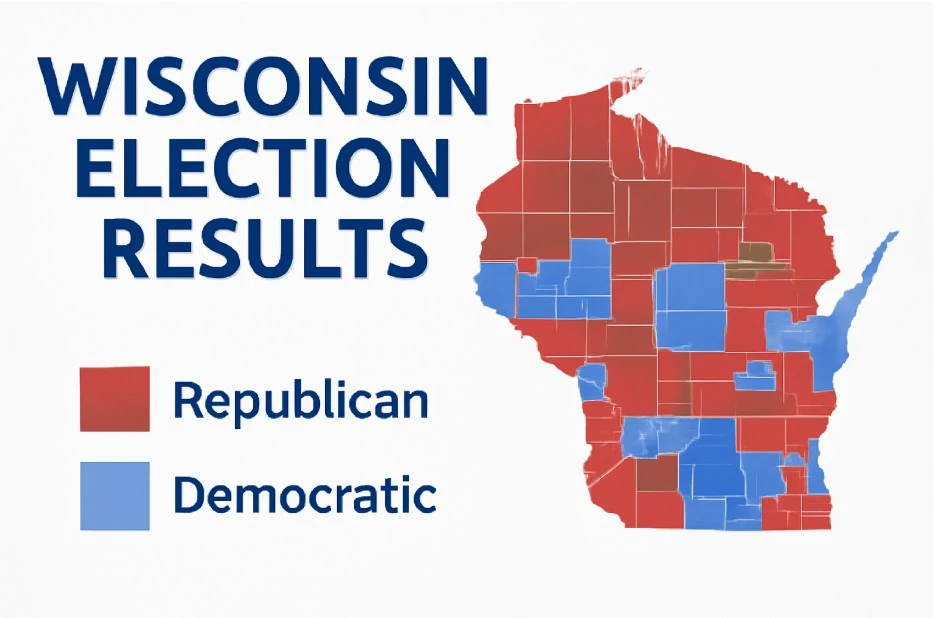5 Key Takeaways from Wisconsin Election Results You Need to Know
Introduction
The Wisconsin election results of 2025 have drawn significant attention due to the state’s pivotal role in national politics. Known for being a key battleground, Wisconsin’s voting outcomes often reflect broader national trends. This article dives deep into the key insights from these results, analyzing voter behavior, political trends, and the implications of the election for future political strategies both in Wisconsin and across the United States.
1. High Voter Turnout: A Key Indicator of Voter Engagement
One of the most striking aspects of the Wisconsin election results was the record-breaking voter turnout. In this election cycle, over 70% of eligible voters participated, the highest in a decade. This surge can be attributed to several factors, including increased voter registration efforts, mail-in ballots, and robust early voting campaigns. The significance of this turnout lies in its ability to reshape the state’s political landscape.
Key Takeaways on Voter Turnout:
-
Increased participation from young voters: The percentage of voters under 30 rose by 10%, signaling a shift in political priorities.
-
Strong performance in urban areas: Major cities like Madison and Milwaukee saw high engagement, which often correlates with Democratic support.
-
Early voting surge: A notable increase in early voting indicates a shift in how voters are approaching elections, with more people choosing convenience over traditional polling day participation.
2. Key Swing Counties That Decided the Outcome
As in past elections, swing counties played a critical role in determining the outcome of the election. In 2025, counties like Waukesha, Outagamie, and Brown were particularly influential. These areas, which have historically leaned Republican, saw a shift towards more balanced support, reflecting broader state and national political shifts.
Key Swing County Insights:
-
Waukesha County: Traditionally a Republican stronghold, showed a slight shift in voting patterns, with a small increase in support for Democratic candidates.
-
Brown County: A close race, with a razor-thin margin, underscoring the changing demographics in suburban areas.
-
Outagamie County: Voter turnout here was high, and early voting played a significant role in pushing the final results.
The Wisconsin election results in these counties highlight the increasing importance of suburban voters, whose concerns about economic policies and social issues have begun to diverge from traditional party lines.
3. The Role of Early Voting in Wisconsin Election Results
Early voting continues to grow in importance in Wisconsin, with over 1.5 million people casting their ballots before Election Day in 2025. The expanded access to absentee ballots and early voting centers helped increase overall voter participation and made the election results more reflective of the state’s diverse population.
Impact of Early Voting:
-
Early voting boosted participation among working-class voters, seniors, and those with mobility issues, allowing them more flexibility.
-
Urban areas saw higher rates of early voting, which tends to favor Democratic candidates.
-
A significant number of first-time voters participated through early voting, making it a critical demographic for both parties.
This growing trend suggests that early voting will play an even bigger role in future Wisconsin elections, especially in an era of increased voting access and political mobilization.
4. Wisconsin Election Results: What Do They Mean for National Politics?
The Wisconsin election results have far-reaching implications for national politics, especially in light of the state’s role as a swing state in presidential elections. With the 2024 and 2028 presidential races in mind, these results offer a glimpse into potential voting patterns and political strategies that could affect the balance of power in Washington.
National Implications:
-
Voter alignment: The results suggest that Wisconsin may continue to serve as a bellwether for national trends, with the shifting demographics in suburban areas making it a key state to watch.
-
Impact on presidential candidates: Both major parties are likely to intensify their focus on Wisconsin in the coming years, investing heavily in outreach programs aimed at young voters and suburban families.
-
Electoral college significance: As a swing state, Wisconsin remains crucial in determining the outcome of presidential elections. The results of this year’s election will likely influence campaign strategies for 2028.
Political analysts agree that Wisconsin will remain a battleground state, and the lessons learned from 2025 will serve as a foundation for future election campaigns.
5. Key Candidates and Their Influence on Wisconsin Election Results
The influence of key candidates cannot be understated in this year’s election. Candidates who focused on economic issues, healthcare, and social reforms resonated deeply with Wisconsin voters. The race was particularly influenced by candidates who advocated for policies aimed at addressing local concerns such as education funding and healthcare access.
Key Candidates’ Impact:
-
Democratic Candidates: Focused on social justice, healthcare reform, and expanding access to education, which resonated with urban voters and younger demographics.
-
Republican Candidates: Emphasized tax cuts, economic growth, and traditional family values, drawing significant support from rural and suburban voters.
-
Independent Candidates: Played a pivotal role in capturing votes from disillusioned voters, especially in swing counties, demonstrating that Wisconsin’s political environment is increasingly favorable to third-party candidates.
Conclusion:
The Wisconsin election results of 2025 provide crucial insights into the state’s evolving political landscape. The record-high voter turnout, shifting swing county dynamics, and the growing importance of early voting all point to a state in transition. For both local and national politics, these results are a reflection of broader societal changes and indicate the direction Wisconsin is likely to take in future elections.
As we move closer to the 2028 presidential election, the Wisconsin election results will undoubtedly shape the strategies of both major parties. Keeping an eye on the state’s political trends will be crucial for understanding the nation’s future political direction.





